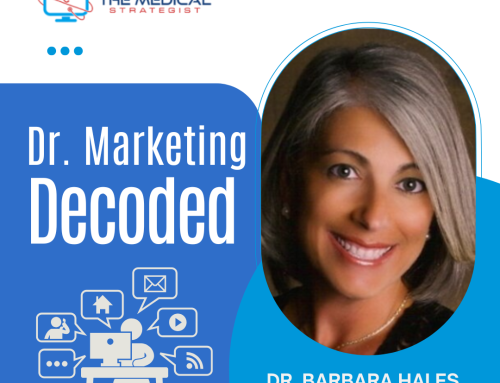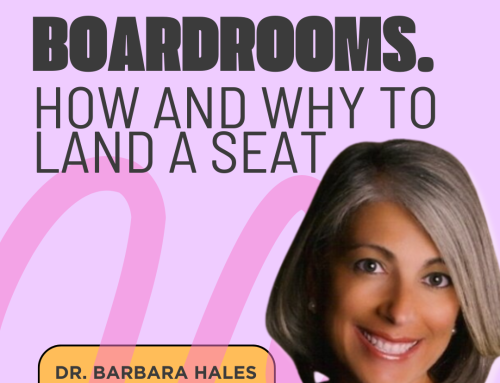Podcast: Play in new window | Download
Subscribe: RSS
In this episode, Barbara and Andrew discuss:
- How Telehealth services can be utilized by doctors.
- The changing of telehealth right now due to the Coronavirus.
- Different forms that telehealth can take.
Key Takeaways:
- While recently popular, telehealth has been used for years, including by the VA for psychiatric services for a backlog of patients, and remote patients with NASA doctors.
- To know which telehealth service is correct for you, you must first know why you are wanting to utilize telehealth.
- Telehealth is taking place all the time to provide services to hospitals who may not have that particular department or speciality on staff.
“Things are evolving very, very quickly. People are finding different ways of applying telehealth all the time.” — Dr. Andrew Bern
Transcription
Barbara: Welcome to the latest episode of Marketing Tips for Doctors. This is your host, Dr. Barbara Hales. Today, we have with us Dr. Andy Bern, who is an emergency physician who is also specialized in disaster medicine and telehealth so this is a great asset to our country in this time of need. Welcome Andrew.
Andrew: Thank you
Barbara: Well I’d like to tell you a little bit about Dr. Bern. He did his medical training in Downstate Medical Center in Brooklyn, NY and then he worked in the emergency room since 1981 in Ohio, Florida, Alabama and Louisiana. As I said, his area of work includes emergency medicine, disaster medicine and telehealth. He has received multiple awards including the Pam B. Trenton Trail Blazing Award in 2019 which was a Lifetime Achievement on an Individual who made the most impact on the specialty of emergency medicine. Well that is pretty impressive Dr. Bern.
Andrew: Thank you
Barbara: How can a doctor use telehealth services.
Andrew: Telehealth actually goes back quite a way. It actually began in the early 70’s as a project between NASA and the Indian Health Service. The problem they were trying to deal with there is providing healthcare to the tribes and individuals that were considered remote and very, very rural and they didn’t have access to healthcare clinics or a physician. In this project with the Indian Health Service they set up satellites and connected them with physicians back at NASA and NASA used this technology that they developed for deployment with the astronauts and the astronaut programs that took place later in the 70’s.
Barbara: Well there are a lot of doctors who had not been using telehealth that are trying to jump on the bandwagon now that they are not seeing their healthy patients. What should you look for as a doctor in terms of choosing a telehealth service since there is more than one around?
Andrew: There are multiple telehealth services around. I think the biggest change that has happened in the last week, in that last week CMS Center for Medicare/Medicaid Services has made a relaxation of the rules for the use of telehealth and getting your reimbursement and the HIPPA have also been relaxed in terms of using devices that have been pre-authorized or certified as HIPPA compliant. Both of those rules have been relaxed in the coronavirus.
For my colleagues they are using, for example, their smart phones after making contact with a patient to conduct the rest of the interview over their phone and the patient’s phone and limit their exposure to potential coronaviruses. So that’s a unique use that is taking place right now.
Telehealth is used in a big way which started a number of years ago when the VA Medical System was unable to in a timely basis screen all of their patients that had PTSD or thought they had PTSD. They were required to be screened by a psychiatrist within a fixed period of time. There were too many patients and too few psychiatrists and the VA Medical System let out a contract for telehealth psychiatry to clear out their backlog of patients. That was one of the very first large deployments of telehealth.
Telehealth has also been used in the area of neurology, in the context of a stroke for hospitals that didn’t have neurologists, didn’t have the ability to provide rapid access for eligible patients with TPA because they #1 didn’t have a neurologist available or they didn’t have a neuroradiologist or a radiologist to read the CAT scans or MRI’s before delivering that modality.
Additionally in rural healthcare settings, they might have an ICU bed but not intensiveness to monitor the patients and give consultations on what is going on and that context you’re having telemedicine come in to help fill that need.
The other need that is being met right now with telemedicine is in some hospitals they’re using a new system to allow physicians to do screen exams which is known as the medical screen exam MCE’s by physicians and in some cases with hospitals other healthcare providers like nurse practitioners to provide that information and reduce physical contact with the patient particularly in this context of the coronavirus.
Barbara: Okay so as a doctor, let’s say I’m trying to decide which telehealth service is right for me, what criteria do you suggest in choosing the telehealth service?
Andrew: I would take it one step further backward. What I mean by that is you have to answer the question why is it that you want to use telehealth to begin with. There are lots of different reasons to use telehealth.
For me I personally worked with a company that did telehealth in other countries like Ghana and they were doing that under a grant from a missionary group and they connected you with people in Ghana that had medical issues and medical problems and you helped them out in a two-way individual communication with those patients.
Other individuals have different reasons for using telehealth so one of the things that are taking place right now for example is patients that have congestive heart failure and are released from the hospital relatively early are being monitored closely by telehealth by the people from those programs and they could be nurse practitioners, they could be cardiologists, they could be a variety of individuals. So that is taking place. You really have to first answer the question why is that you want to get involved with telehealth.
Barbara: Is the telehealth coming from the hospitals and insurance companies that a doctor participates in or can a doctor say “Look, I don’t want to close my practice. I still want to see patients. I don’t want to lose all of my revenue but I want to see them online.” Is there a telehealth service that they could get right now for their patients right now locally?
Andrew: That is an important question but the main driver of this has been the fact that up until this point telehealth services reimbursed very poorly. That is because of the rulings from CMS and state government. There was not a lot of incentive for physicians to go into telehealth because of the reimbursement issue. Because of the change in the environment and the pandemic issues that have arisen there have been some changes.
For a physician that wants to maximize their ability to use telehealth at a reasonable compensation the established programs that are operating out of hospitals or even from insurance companies are probably the better choice. There are a lot of people that are approaching physicians saying I have this great system and you have to invest this much money and buy equipment that I have. Stuff like that. I think for most people you first have to ask yourself the question why do I want to do this? What need am I meeting and then if you have economic means it may determine what kinds of services you get. Telehealth services work best when you have a fast channel of communication.
Personally, I have a 45 megabit/second ATT internet connection which is fine for my needs. Other people actually have gigabit connections which when you start get heavy use that is obviously better. So, a lot of these things really depend upon what your capabilities are and realizing that some services are a turnkey system. They provide all of the equipment, they provide all of the connections, they provide the billing structure and they’re very good in doing that. Then there are other companies whose motivation is just selling you equipment.
Barbara: I think that’s a great word to keep in mind…turnkey. Because now I think everyone is just looking for all of the equipment to be given to them without having to make a big investment so that they could jump up to the plate and start seeing their patients right away. But tell me how do doctors link their service to an insurance billing company when they’ve seen patients online?
Andrew: Well it usually goes the other way around. So for example, if you look at Humana or Aetna or a company of that nature they decide that in their policy they’re going to start bringing in the feature telehealth and working through those companies they generate a contract that you will provide a certain service for them and have it available through telehealth mechanisms. Different companies are different and it really depends upon what companies you’re working with.
Several hospitals are looking to expand their use of that as well and within their medical staffs they communicate that they’re looking for physicians to participate and what the financial arrangements are going to be and they are making all of the outlays in terms of equipment, software, billing, things of that nature.
Barbara: Are you seeing more patients trying to access telehealth now s that they don’t have to go to an office during these trying times?
Andrew: I think that is taking place but for the most part you’re dealing with a population where either their employer has arranged a contract to allow them to be screened and evaluated to do that or they are contacting their individual physicians and find out that the office is closed except for extreme emergencies and they are falling back now on typical communications like FaceTime and smartphone usage because those rules have been relaxed.
Barbara: Do you find that a lot of doctors have their phones encrypted now to have communication with patients?
Andrew: No and that is the big challenge. Before people did not have HIPPA compliant phones and software to do that but as I’m saying in the pandemic that we’re experiencing now there has been a relaxation of the rules to allow people to do that without those considerations.
Barbara: Well we’ve been talking with Dr. Bern. He has had a very involved relationship with the American College of Emergency Physicians Organization and he is currently working with the state legislative regulatory committee, the Federal Government Affairs Committee, The Awards Committee and the Disaster Committee. He is published extensively and lectures. Since 2012 he has also spoken with Toastmasters International achieving the distinguished Toastmaster Award in 2016.
So, Dr. Bern tell us the different forms that telehealth takes.
Andrew: Well I can go through a number of different examples where its used. Telehealth is used on a regular basis in the military particularly for troops that are in areas where medical care is not eminently available. Telehealth is used in rural settings allowing specialists to come and be part of the management of patients that require for example intensiveness, neurologist and other specialties that are not resident at those hospitals.
Telehealth is being used for monitoring patients that are high risk such as dialysis patients or congestive heart failure patients and keeping that contact between the physician and the hospital and the patient. Allowing patients to be discharged safely and earlier and not be kept in the hospital because somebody is able to physically see and watch them and keep a good maintenance on what is going on.
There is a standard telehealth in the area of psychiatry which I mentioned before where the Veterans Administration were using that system extensively. There are other opportunities for telehealth as well. Many people have noticed commercials on TV talking about the innovations of 5G for your phone. That essentially from today’s standard is 100 times faster than where we are now. And they’re talking about doing things like remote access surgery with robotics because you have 5G technology allowing you to literally do surgeries remote just with the technology of a smartphone with 5G capability. So things are revolving very, very quickly and people are finding different ways of applying telehealth all of the time.
When I was in Hawaii, for example, I had an accident and I went to a hospital that didn’t have any physicians or radiologists there initially. They had to call in the emergency physician from his home to see me.
By that time, I had already taken my x-rays. We reviewed them and then they sent the x-rays by teleradiology to the radiologist on the other side of the island to do the official reading. This is taking place all of the time. So, you have teleradiology, you have teleneurology, you have telepsychiatry, you have teleinvasive care, you have telemedicine being used to supplement staffing for emergency departments and triage and doing the medical screening exam that is required under corona and you’re having it being used as a bridge for physicians who are trying to talk to patients and limit their exposure if the patient is thought to be a patient affected by the coronavirus.
Barbara: This is quite impressive. Well thank you so much for joining us today on this episode Dr. Bern. You’ve been listening to Marketing Tips for Doctors with your host Dr. Barbara Hales. Until next time…
Connect with Barbara Hales:
Twitter: @DrBarbaraHales
Facebook: facebook.com/theMedicalStrategist
Business website:www.TheMedicalStrategist.com
Show website: www.MarketingTipsForDoctors.com
Email: Barbara@TheMedicalStrategist.com
Books:
YouTube: TheMedicalStrategist
LinkedIn: www.linkedin.com/in/barbarahales



